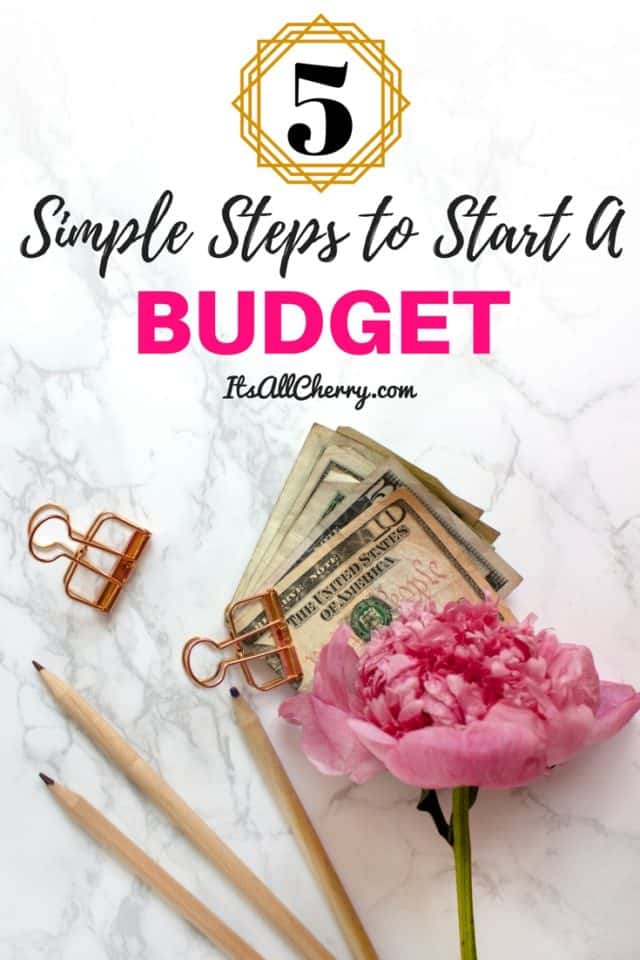This post contains affiliate links where I receive a comission for purchases made through my links at no cost to you. Read my disclaimer for more information.
After years of wondering why I was broke so quickly after payday, I realized that I needed to organize my finances especially as my student loan statements and bills started to pile up. I tried different methods and it took me several months to find a system that worked for me. I also changed my payment deadlines to align with my working budget. Then, when my husband and I married in 2015, it took us over a year to consolidate our finances.
Creating a family budget helped us to gain a better picture of our finances. Starting a budget is not fun but it is a necessary tool to help you and your family keep track of expenses, save money, and plan for the future. Here are five simple steps to help you start a budget:
Figure out how much money you’re making
Look at your pay statements. The amount titled “net pay” is what you have after taxes and deductions (work sponsored health benefits, retirement, etc.) have been subtracted. This is what is deposited in your bank account if you have direct deposit or is paid to you as a check. This is the amount that you will use to build your budget.
You must then figure out how often you get paid: weekly, bi-weekly, monthly, etc. If you have an irregular salary or pay date, get an average of your total salary for the past 6-12 months. In addition, you have multiple sources of income (ex: if you are married and/or work multiple jobs), then use the total amount of all income to begin your/your family’s budget. For example,
Husband’s Job 1: $1000 every 2 weeks x 2 pay dates = $2000
Husband’s Job 2: $500 every month = $500
Wife: $1000 every 2 weeks x 2 pay dates = $2000
Wife’s Job 2: $250 every 2 weeks x 2 pay dates = $500
Total Net Income a Month: $5,000
Determine your fixed expenses
Make a list of expenses that have a fixed deadline every month. These include rent, car payments, insurance, utilities, phone, and all debt (credit card, student loans, etc). In one column, list your expenses. In the second column, write down the monthly deadline to pay. List your expenses in the order of due dates so you can easily see what needs to be paid next.
You could also write down the total amount of debt you owe in a third column so you can see how much more you have to pay down. My spreadsheet has changed so much over time. It’s up to you and your family as to how your information is organized. The important thing is to write everything down so you can check off what has been paid and what hasn’t by the end of the month.
List discretionary expenses
Write down your average monthly expenses for discretionary expenses. These include food, gas, entertainment, books (if you are a student), subscriptions (ex: Netflix), gym membership, etc. Look at your old bank statements or receipts to figure out how much you spend on these categories.
This is also the area that you will play around with the most to balance your budget. In addition, you should include expenses that occur irregularly like car registration so you can anticipate the payment
If you need help cutting back in this area, check out my post on saving money on groceries, clothes, and eating out.
Look at the bottom line
Calculate the total amount of your income minus the total amount of your fixed and discretionary expenses. This will give you your balance. If you have leftover money, that’s great! You can put it towards paying down debt, savings or another financial goal.
If you come up with a negative number, then you need to adjust your income or expenses so that you can have a balanced budget. For example, you may need to earn more income by getting a second job. You could also cut back on your discretionary expenses such as entertainment or limit eating out to once a week.
In addition, you can reduce your fixed expenses by exploring different options to lower your bills. Some of these include: getting a cheaper phone plan, consolidating your student loans, and finding cheaper life insurance or health care plans (just make sure you don’t cut costs by cutting important benefits you may need!).
Set goals
Setting goals is an important part of creating a budget. Some short-term goals could include paying down your car loan or saving up for a down payment on a house. You must also have an immediate goal of saving up for an emergency fund of 3-6 months’ worth of income.
You shouldn’t just think that your income is just to pay for your day-to-day living expenses. Set up your budget in a way that will help you realize your dreams, such as traveling or starting a business, even on a limited income.
Starting a budget will take some time and work but having a budget will give you a clear picture of your current finances to help you plan for a future that you’ve always wanted.

